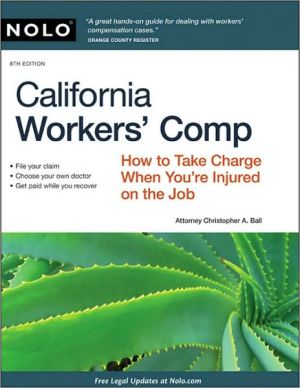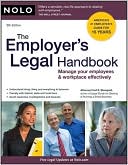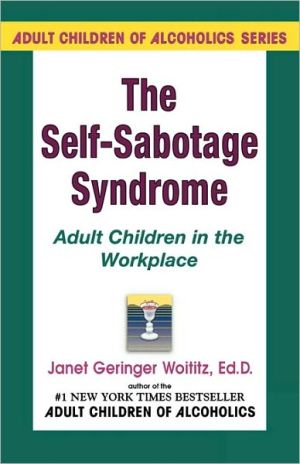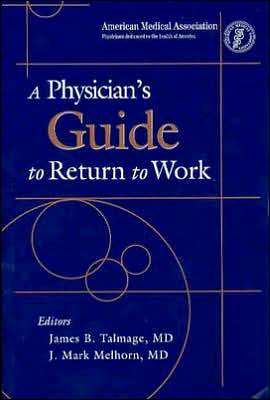California Workers' Comp: How to Take Charge When You're Injured on the Job
Handle your California workers' compensation claim and maximize your benefits!\ From industrial injuries to carpal tunnel syndrome, more than a million Californians a year suffer job-related injuries or illness. For many, receiving compensation can be a nightmare, since recent laws give employers and insurance companies far greater rights and employees fewer medical benefits.\ \ California Workers' Comp shows you how to handle a California workers' compensation claim from start to...
Search in google:
Handle your California workers' compensation claim and maximize your benefits! From industrial injuries to carpal tunnel syndrome, more than a million Californians a year suffer job-related injuries or illness. For many, receiving compensation can be a nightmare, since recent laws give employers and insurance companies far greater rights and employees fewer medical benefits.California Workers' Comp shows you how to handle a California workers' compensation claim from start to finish. With this plain-English guide, you'll learn how to work with your insurance company to receive the medical treatment and benefits you deserve. Find out how to:file a claim protect your legal rights receive the medical care you need get the benefits you're entitled to deal with uncooperative employers, doctors and insurance agencies negotiate a settlement present your case before a judge Turn to California Workers' Comp to get the benefits you're entitled to. This complete guide can help you whether you're handling your own claim or filing on a minor or other's behalf. The 8th edition is completely updated to cover significant changes in the area of permanent disability ratings, along with recent updates to the Labor Code and other workers' comp laws. Plus, read a new chapter with information tailored to computer users with repetitive strain injuries. Orange County Register "A great hands-on guide for dealing with workers' compensation cases."
Introduction\ \ If you've been injured on the job, your workers' compensation claim will stumble and saunter its way through the workers' compensation system. It will seem that all you do is wait for something to happen. When you request medical treatment, you may wait weeks for a response. You may wait for a doctor's appointment, then wait for the medical report. And if you file for a hearing before the Workers' Compensation Appeals Board, you may wait months for your hearing date.\ \ And so it will go. At every turn, it is likely to take months before anything is accomplished. Unfortunately, it probably won't make you feel much better to realize you are not alone. An average workers' compensation case takes two to three years to be resolved. And many cases take much, much longer.\ \ It probably won't come as a surprise that the workers' compensation system is bureaucratic: Lots of forms, reports, and other documents are shuffled through what sometimes seems like an endless maze. Above all, the workers' compensation system is confusing. It's fraught with rules and regulations-and it sorely lacks understandable information for the injured worker.\ \ This chapter helps take the mystery out of the workers' compensation system by clearly outlining the steps involved in a "typical" workers' compensation case. Inevitably, there will be some variations depending on your particular situation and whether or not you're represented by an attorney. But the basic steps are usually similar in all workers' compensation cases.\ \ Death Claims. If you were totally or partially dependent upon someone who died due to an industrial injury, you may have a workers' compensation claimfor death benefits. Skip ahead to Chapter 15.\ Step 1. Notify Your Employer of the Injury\ \ If you sustain a work injury, notify your supervisor or boss of the injury at your first opportunity. If your injury developed over a period of time, as with a repetitive stress, or cumulative trauma, injury, notify your employer as soon as you have symptoms and realize you've been injured as a result of your job.\ \ Although you may initially tell your supervisor orally of the injury, it is important that you also give your employer written notice within 30 days of the injury. This will prevent any misunderstanding about whether or not you reported the injury and will protect your right to workers' compensation benefits.\ \ If you have a union representative, contact that person right away; you may need help obtaining additional benefits that are secured by a union contract. (Your union representative may be instrumental in protecting your legal rights should your employer attempt to terminate you because you can't return to work for a while. Also, some employers may have salary continuation agreements for union members injured at work.)\ \ Make certain that you complete any required inhouse accident reports. Also, review any accident reports prepared by your supervisor or employer for accuracy, and obtain a copy for your records. If you disagree with the report, write your employer a letter explaining your position. (Chapter 5 takes you through all the rules and procedures involved with reporting your injury and filing a claim.)\ Step 2. Get Medical Treatment If Needed\ \ It is important to promptly seek medical treatment if needed. Not only will prompt medical treatment protect your health, but it will establish a medical record of your work injury.\ \ If you gave your employer the name of your own doctor before your injury ("predesignated your treating physician," in workers' compensation jargon), you may go to that doctor under certain conditions (see Chapter 9, Section B1).\ \ If not, the employer usually has the right to send you to a doctor the employer chooses, which often turns out to be the "company doctor" or "medical provider network"-a doctor or medical clinic that the employer sends its injured workers to on a regular basis.\ \ If you have a medical emergency that requires immediate medical attention, you may go to the nearest emergency room for treatment. But after your emergency medical condition has been stabilized, you must continue follow-up medical treatment with the physician selected by your employer, unless you designated a doctor in advance. (See Chapter 9 for a detailed discussion of medical care.)\ Step 3. Paying for Medical Treatment If Employer Denies Your Claim\ \ If you report what you believe to be a work-related injury to your supervisor, your employer will most likely agree to accept responsibility. Authorization for medical treatment may be given orally or in writing to the doctor by your employer or its workers' compensation insurance company.\ \ Within one day of your filing the DWC-1 claim form (see Step 6), your employer or its insurance company is required to authorize and agree to pay for your medical treatment until your employer or the insurance company either accepts or denies your claim. The insurance company is liable only for $10,000 in medical treatment until it accepts or denies your claim. (LC 5402(c).)\ \ If your claim is eventually accepted, the employer or insurance company will continue to pay for your treatment. If your claim is denied, the employer or insurance company will not authorize further medical treatment. This may work to your advantage (assuming that you have a valid claim): By denying your claim, your employer gives up its right to control your medical treatment. If your claim is denied, you are not bound to go to the company doctor for treatment and may be treated by a doctor of your choice. (See Chapter 9, Section B, for details.)\ \ If your employer denies your claim right away, seek prompt treatment by relying on private health insurance, if you have it. If you do not have medical insurance and your employer refuses to pay, you have three choices. You may pay for treatment yourself and seek reimbursement later. You may find a doctor to treat you on a "lien basis," where the doctor waits for payment until your workers' compensation case is settled. (See Chapter 9, Section B2b, for more on liens.) Or you may get a judge to order your employer's insurance company to pay for treatment. An information and assistance officer can help with this procedure. (See Step 10, below.)\ \ Always apply for state disability insurance (SDI). Whenever you have an injury that results in your inability to work, always-and immediately-apply for SDI from the Employment Development Department (EDD). That way, you'll receive income from this source in case of a delay or denial of your claim. When your workers' compensation benefits begin, it's important that you promptly inform the EDD, so it will discontinue SDI payments. (You may also be entitled to retroactive temporary disability benefits from the insurance company if you received less in SDI payments than you would have from the workers' compensation insurance company.) We cover SDI in Chapter 17, Section A.\ Step 4. Tell the Doctor About Your Injuries\ \ The doctor's first report will often be relied upon by the insurance company to determine the extent of your injuries and whether they resulted from your employment. Tell the doctor that you injured yourself at work (if that's true) and how the injury occurred (if you know). In addition to giving the doctor a complete history of your medical problems (if asked), be sure to cover all your symptoms and sources of pain. For instance, even if most of your pain is in your back, if your arm hurts even a little, tell the doctor! You'll find detailed information on dealing with doctors in Chapter 9.\ Step 5. The Doctor Decides If You Need Time Off\ \ The first doctor you see will probably determine whether or not you need some time off from work to recover from the effects of your injury. Depending on the doctor's findings, you will receive one of the following:\ \ * off-work order\ * limited duties work order (also called a light duty work order or modified work order), or\ * return to work order-that is, you can return to work with no restrictions.\ \ Especially if you are given an off-work order, it's essential that you keep your employer advised of your medical status. If you neglect to do so, you may be fired for failing to report to work without a valid excuse. If, however, you keep your employer informed, you cannot legally be fired for injuring yourself, filing a workers' compensation claim, and obeying doctor's orders.\ Injured Workers Who Are Fired
Part I: All About Workers' Compensation1. Introduction to Workers' CompA. What Is Workers' Compensation?B. What an Injured Worker Is Entitled ToC. Where to Get Additional Information and HelpD. How to Use This BookE. What This Book Does Not Cover2. Overview of a Workers' Compensation Claim Step 1. Notify Your Employer of the InjuryStep 2. Get Medical Treatment If NeededStep 3. Paying for Medical Treatment If Employer Denies Your ClaimStep 4. Tell the Doctor About Your InjuriesStep 5. The Doctor Decides If You Need Time OffStep 6. Complete Workers' Compensation Claim Form and Application forAdjudication of Claim FormStep 7. Secure Control of Your Medical CareStep 8. You May Receive Temporary Disability BenefitsStep 9. Handling a Denial of Your Claim or BenefitsStep 10. Taking Problems to the Appeals BoardStep 11. After You Are Determined to Be Permanent and Stationary (P&S)Step 12. You May Recover Completely and Return to WorkStep 13. You May Be Entitled to Vocational RetrainingStep 14. You May Be Permanently DisabledStep 15. Go to Trial If There Is No SettlementStep 16. Judgment Is Paid or the Matter Is Appealed3. Is Your Injury Covered by Workers' Compensation? A. Is Your Job Covered by Workers' Compensation?B. Do You Have a Compensable Injury?C. Injuries Not Covered by Workers' Compensation4. Cumulative Trauma DisordersA. What Is a CTD?B. Becoming Aware of Your InjuryC. Diagnosis and TreatmentD. Recovery and Permanent InjuriesE. Returning to the WorkforceF. Further Medical TreatmentPart II: Protecting Your Rights5. What to Do If You're InjuredA. Request Medical TreatmentB. Report the Injury Within 30 DaysC. File Your Workers' Compensation ClaimD. The Insurance Company's AnswerE. Take Steps to Protect Your Rights6. Keep Good Records to Protect Your Claim A. Set Up a Good Record-Keeping SystemB. Read and Understand What You Receive in the MailC. Gather Important Records Pertaining to Your ClaimD. Request Copies of Documents and EvidenceE. Keep Your Address Current7. The Insurance Company's Role A. Self-Insured EmployersB. The Insurance Company's ResponsibilitiesC. Your Responsibilities as an Injured WorkerD. Who's Who in the Insurance CompanyE. How to Deal With the Insurance CompanyF. Tactics Insurance Companies Use to Deny or Minimize ClaimsG. Settling Your Case8. Dealing With Your Employer A. Self-Insured EmployersB. The Employer/Insurance Company RelationshipC. The Employer's ResponsibilitiesD. If You're Out of Work Due to the InjuryE. Bankruptcy or Other Employer Financial Problems9. Taking Charge of Your Medical Case A. What the Treating Doctor DoesB. Choose Your Treating Doctor (Get Medical Control in Your Case)C. Be Sure You Receive Excellent Medical CareD. Changing Treating DoctorsE. When Your Condition Becomes Permanent and Stationary (P&S) or Has Reached Maximal Medical Improvement (MMI)10. Medical-Legal Evaluations A. Rules for Medical-Legal EvaluationsB. Compensability of Injury (Labor Code § 4060)C. Nature and Extent of Permanent Disability or Need for Future Medical Treatment (Labor Code § 4061)D. Other Issues to Be Resolved by Medical-Legal Evaluations (Labor Code § 4062)E. Picking a Qualified Medical Evaluator (QME)Part III: Workers' Compensation Benefits11. Medical BenefitsA. Limitations on Medical TreatmentB. Payment for Current Medical Treatment and EvaluationsC. Future Medical Care CostsD. Penalties12. Temporary Disability Benefits A. Qualifying for Temporary DisabilityB. Amount of Temporary Disability PaymentsC. How Payments Are Made13. Permanent Disability (and Life Pension) A. How Permanent Disability Payments Compensate YouB. Kinds of Permanent Disability AwardsC. Establishing Your Permanent Disability StatusD. How Permanent Disability Benefits Are PaidE. Amount of Permanent Partial Disability BenefitsF. Life Pension BenefitsG. Permanent Total Disability Benefits14. Vocational Rehabilitation/Supplemental Job Displacement Benefit A. Vocational Retraining and Offers of Alternative or Modified WorkB. What Is Vocational Rehabilitation?C. Six Steps in a Vocational Rehabilitation PlanD. Eligibility for Vocational Rehabilitation (QIW Status)E. How to Start Vocational RehabilitationF. Delays and Failure to Provide Rehabilitation ServicesG. Preparing a Vocational Rehabilitation PlanH. Completing a Vocational Rehabilitation PlanI. Where to Get Help With Vocational RehabilitationJ. Supplemental Job Displacement Benefit15. Death Benefits A. Who May Receive Death BenefitsB. Death Benefit AmountC. Additional Payments for Dependent Minor ChildrenD. Burial Expense for Deceased WorkerE. Unpaid Temporary or Permanent Disability PaymentsF. How Death Benefits Are Distributed16. Extraordinary Workers' Compensation Benefits and Remedies A. Subsequent Injuries Benefits Trust FundB. The Uninsured Employers Benefits Trust FundC. Discrimination Benefits (Labor Code § 132(a))D. Employer's Serious and Willful Misconduct17. Benefits and Remedies Outside the Workers' Compensation System A. State Disability (SDI)B. Social Security BenefitsC. Claims or Lawsuits for Personal InjuriesD. Claims or Lawsuits Based on DiscriminationPart IV: Settling Your Case18. Rating Your Permanent DisabilityA. Obtaining a RatingB. What Is Involved in the Rating Process?C. How to Rate a Disability Using the New Rating ScheduleD. Other Considerations in Rating a Permanent DisabilityE. How to Rate a Disability Using the Old Rating ScheduleF. How to Use the Pre-1997 Rating Manual19. Figure Out a Starting Settlement Amount A. What You May Receive in a SettlementB. Two Kinds of SettlementsC. Determine the Value of Your Claim Using the Settlement WorksheetD. What to Do Next20. Negotiating a Settlement A. Deciding Whether to Negotiate Your Own SettlementB. The Concept of CompromisingC. How to Negotiate a SettlementD. Review and Sign Settlement DocumentsE. Attend an Adequacy HearingPart V: The Workers' Compensation Appeals Board21. Preparing Your CaseA. Identify Possible Issues in DisputeB. How to Prove (or Disprove) Disputed IssuesC. DepositionsD. Subpoenaing Witnesses and DocumentsE. Preparing for a Pre-Trial HearingF. Preparing for a Trial22. Arranging for a Hearing or Trial A. Kinds of HearingsB. Trial on Preliminary IssuesC. Trial on Entire Case (the Case-in-Chief)D. File a Declaration of Readiness to Proceed to Set Your Case for HearingE. Copy, Serve, and File DocumentsF. Receiving Notice of a Hearing23. How to File and Serve Documents A. What Is Service of Documents?B. How to Serve Documents by MailC. How to Serve Documents PersonallyD. How to Serve Documents by FaxE. How to File Documents With the Workers' Compensation Appeals Board24. Going to a Hearing or Trial A. Finding Your Way Around the Appeals BoardB. Pre-Trial ConferencesC. TrialD. Findings and Award25. Appealing a Workers' Compensation Decision A. The Three-Step Appeal ProcessB. Petition for ReconsiderationC. Writ of Review With the Appellate CourtD. Writ of Appeal to the California Supreme CourtPart VI: Beyond This Book26. Lawyers and Other Sources of AssistanceA. Information and Assistance OfficersB. Hiring a Lawyer27. Legal Research A. Find a Law LibraryB. The Basics of Legal Research28. Case Law Review CHAPTER 3-IS YOUR INJURY COVERED BY WORKERS' COMPENSATION?CHAPTER 5-WHAT TO DO IF YOU'RE INJUREDCHAPTER 9-TAKING CHARGE OF YOUR MEDICAL CASECHAPTER 10-MEDICAL-LEGAL EVALUATIONSCHAPTER 11-MEDICAL BENEFITSCHAPTER 12-TEMPORARY DISABILITY BENEFITSCHAPTER 13-PERMANENT DISABILITY (AND LIFE PENSION)CHAPTER 14-VOCATIONAL REHABILITATION/SUPPLEMENTAL JOB DISPLACEMENT BENEFITCHAPTER 15-DEATH BENEFITSCHAPTER 16-EXTRAORDINARY WORKERS' COMPENSATION BENEFITS AND REMEDIESCHAPTER 18-RATING YOUR PERMANENT DISABILITYCHAPTER 19-FIGURE OUT A STARTING SETTLEMENT AMOUNTCHAPTER 20-NEGOTIATING A SETTLEMENTCHAPTER 21-PREPARING YOUR CASECHAPTER 22-ARRANGING FOR A HEARING OR TRIALCHAPTER 24-GOING TO A HEARING OR TRIALAppendixesA1: Workers' Compensation OfficesA2: Temporary Disability Benefits Compensation ChartA3: Permanent Disability Indemnity ChartA4: Maximum Life Pension Weekly Payments for Injuries Between 7/1/96 and12/31/02A5: Workers' Compensation FormsForms to File With the Division of Workers' CompensationDWC-1: Workers' Compensation Claim FormApplication for Adjudication of ClaimDeclaration in Compliance With Labor Code Section 4906(G)Declaration of Readiness to ProceedDeclaration of Readiness to Proceed to Expedited Hearing TrialPre-Trial Conference StatementNotice of Change of AddressProof of ServiceCover Letter to Workers' Compensation Appeals BoardRecord-Keeping Forms and WorksheetsRecord of Income and Benefits ReceivedRecord of Time Off WorkRecord of Medical Expenses and Request for ReimbursementRecord of Mileage Transportation and Request for ReimbursementSettlement Worksheets and DocumentsSettlement Worksheet: Value of Workers' Compensation ClaimStipulations with Request for AwardCompromise and ReleaseForms to File With Your EmployerEmployee's Designation of Personal PhysicianLetter to Employer Requesting Copies of Documents and Evidence
\ Orange County Register"A great hands-on guide for dealing with workers' compensation cases."\ \







